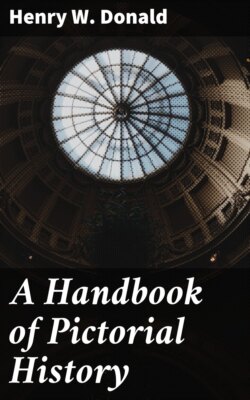Читать книгу A Handbook of Pictorial History - Henry W. Donald - Страница 5
На сайте Литреса книга снята с продажи.
THE BRONZE AGE.
ОглавлениеTable of Contents
The Iberians were succeeded by the Celts, who conquered, and probably intermarried with, the former.
They had a knowledge of the use of metals, and employed copper first for the manufacture of their weapons and tools. Then they learned that, by mixing tin with copper, a harder metal was obtained, which we call bronze, and this period is, consequently, called the Bronze Age. The early bronze weapons were of the same form as the flint weapons, for probably the latter were used as “patterns” for forming the mould. Later, in the case of the celt, flanges were formed at the side, and, finally, a socketed celt was made, showing a considerable skill in its manufacture. “The knowledge of bronze must have affected the warfare of the time in the same way as the introduction of gunpowder affected the warfare of the Middle Ages.” It has been estimated that the Bronze Age commenced in Britain about 1500 B.C.
PLATE 2.
(Fig. 1): A bronze spear head—Later Celtic—in the British Museum. It is probable that the flint spear-head continued in use into the Bronze Age, and that the spear-head with a socket was not invented until socketed celts were made. (Fig. 2): An ornamental bronze celt or axe found in Suffolk. The simpler form of the celt has been improved upon by the addition of flanges. (Figs. 3 and 4) show how they were probably fixed in handles. (Fig. 5): A bronze knife dagger found in the Isle of Wight (British Museum). (Fig. 6): A bronze arrow-head. (Fig. 7): A bronze socketed celt. (Fig. 8): The same, with the probable method of fastening to a handle. (Fig. 9): A bronze cauldron found in Ireland. (Fig. 10): A late Celtic Helmet, ornamented and showing generally in its structure a very advanced skill in manufacture; found in the Thames; now in the British Museum. (Fig. 11): A bronze dagger in the British Museum. (Fig. 12): A bronze spear-head (elongated form), found at Stanwick in Yorkshire; now in the British Museum. Both the spear heads in Figs. 1 and 12 tend towards a leaf form. (Fig. 13): A bronze sword, narrow and leaf-shaped, in the Guildhall Museum, London; showing rivet holes. The sword of the Bronze Age is remarkable for the beauty of its form. The average length of the blade was about two feet, the handle being made of horn or wood, split and rivetted on either, side. The sword was probably encased in a scabbard of leather, wood or bronze.
